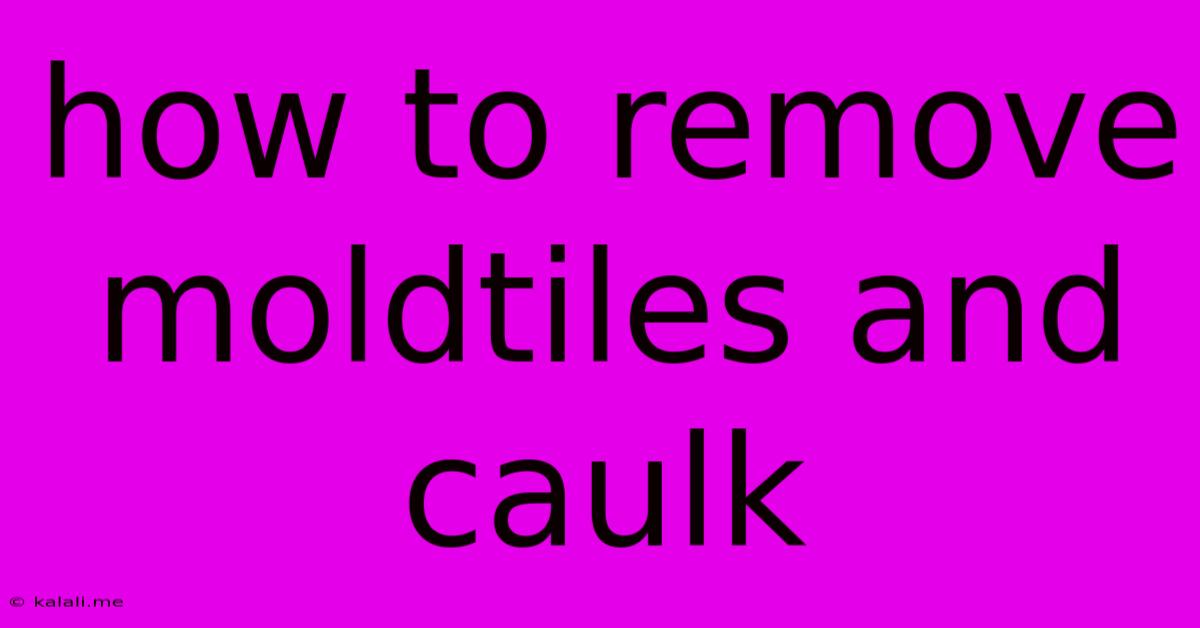How To Remove Moldtiles And Caulk
Kalali
Jun 10, 2025 · 4 min read

Table of Contents
How to Remove Moldy Tiles and Caulk: A Step-by-Step Guide
Mold and mildew in bathrooms and kitchens are common issues, often appearing between tiles and around caulking. This unsightly and potentially unhealthy growth requires prompt removal. This guide provides a step-by-step process for safely and effectively removing moldy tiles and caulk, leaving your surfaces clean and fresh. Remember to always prioritize safety and wear appropriate protective gear throughout the process.
Why Remove Moldy Tiles and Caulk?
Beyond the aesthetic concerns, mold growth poses health risks. Inhaling mold spores can trigger allergic reactions, respiratory problems, and other health issues, particularly for those with pre-existing conditions. Removing affected tiles and caulk is crucial for maintaining a healthy home environment. This is especially important in high-moisture areas like bathrooms and kitchens where mold thrives. Proactive mold removal prevents the spread and minimizes potential health hazards.
Tools and Materials You'll Need:
- Safety Gear: Gloves (nitrile are recommended), eye protection (safety glasses), and a respirator mask (N95 or higher). Mold spores are microscopic and can be easily inhaled.
- Cleaning Solutions: A mold-killing solution (bleach solution – 1 part bleach to 10 parts water, or a commercial mold cleaner), a scrub brush, and a spray bottle.
- Tools for Removing Tiles: A chisel, hammer, utility knife, and possibly a tile removal tool (depending on tile type and adhesive).
- Caulk Removal Tools: A utility knife or caulk removal tool.
- New Caulk: Choose a mildew-resistant caulk specifically designed for bathrooms and kitchens.
- New Tiles (if needed): Select tiles that match your existing ones or complement your desired aesthetic.
- Putty knife: For scraping away old adhesive.
- Shop vacuum: For cleaning up debris.
- Protective drop cloths: To protect surrounding surfaces.
Step-by-Step Removal Process:
1. Preparation is Key:
- Protect the Area: Cover surrounding surfaces with drop cloths to prevent damage from splashes and debris.
- Ventilation: Ensure good ventilation in the area. Open windows and doors, or use an exhaust fan to help disperse mold spores and fumes from cleaning solutions.
2. Removing the Caulk:
- Score the Caulk: Use a utility knife to score the old caulk along its seam. This helps to break the seal and makes removal easier.
- Remove the Caulk: Gently pry away the scored caulk using a caulk removal tool or a putty knife. Be careful not to damage the surrounding tiles. Remove as much of the old caulk as possible.
3. Removing Moldy Tiles:
- Locate Weak Points: Gently tap around the edges of the moldy tiles with a hammer and chisel to identify weak spots in the adhesive.
- Loosen the Tiles: Carefully chisel away at the edges of the tiles to loosen them from the substrate. Work your way around the perimeter until the tile is loose enough to be removed.
- Remove the Tiles: Once the tile is loose, carefully remove it. If the tile is particularly stubborn, you may need to use a tile removal tool. Be mindful to avoid damaging the surrounding area.
- Clean the Area: Once the tiles are removed, thoroughly clean the area with your mold-killing solution. Scrub the area well to remove any remaining adhesive or mold.
4. Cleaning and Preparation for New Materials:
- Deep Clean: Thoroughly clean the area where the tiles and caulk were removed to eliminate any remaining mold spores. Allow the area to dry completely before applying new materials.
- Apply New Caulk: Once the area is clean and dry, apply a bead of new, mildew-resistant caulk along the seams. Smooth the caulk with a wet finger or caulk tool.
- Install New Tiles (if needed): Follow the manufacturer's instructions for installing new tiles. Ensure the tiles are properly adhered to the substrate.
5. Post-Removal Cleanup:
- Dispose of Waste Properly: Dispose of the old tiles, caulk, and cleaning materials according to local regulations.
- Clean Up Debris: Thoroughly clean up any remaining debris and dust using a shop vacuum or wet/dry vacuum.
Important Considerations:
- Extent of Damage: If the mold infestation is extensive or you're uncomfortable tackling the project yourself, consider contacting a professional mold remediation specialist.
- Underlying Issues: Address any underlying issues causing the mold growth, such as leaks or excessive humidity.
By following these steps, you can effectively remove moldy tiles and caulk, restoring the cleanliness and health of your home. Remember safety first and don't hesitate to call a professional if needed.
Latest Posts
Latest Posts
-
Somebody Once Told Me That The World Was Macaroni Lyrics
Jul 02, 2025
-
How Old Are You If Born In 1993
Jul 02, 2025
-
What Is 1 4 Of 1 4 Cup
Jul 02, 2025
-
Is Keri Russell Related To Kurt Russell
Jul 02, 2025
-
What Is Half Of 1 4 Teaspoon
Jul 02, 2025
Related Post
Thank you for visiting our website which covers about How To Remove Moldtiles And Caulk . We hope the information provided has been useful to you. Feel free to contact us if you have any questions or need further assistance. See you next time and don't miss to bookmark.